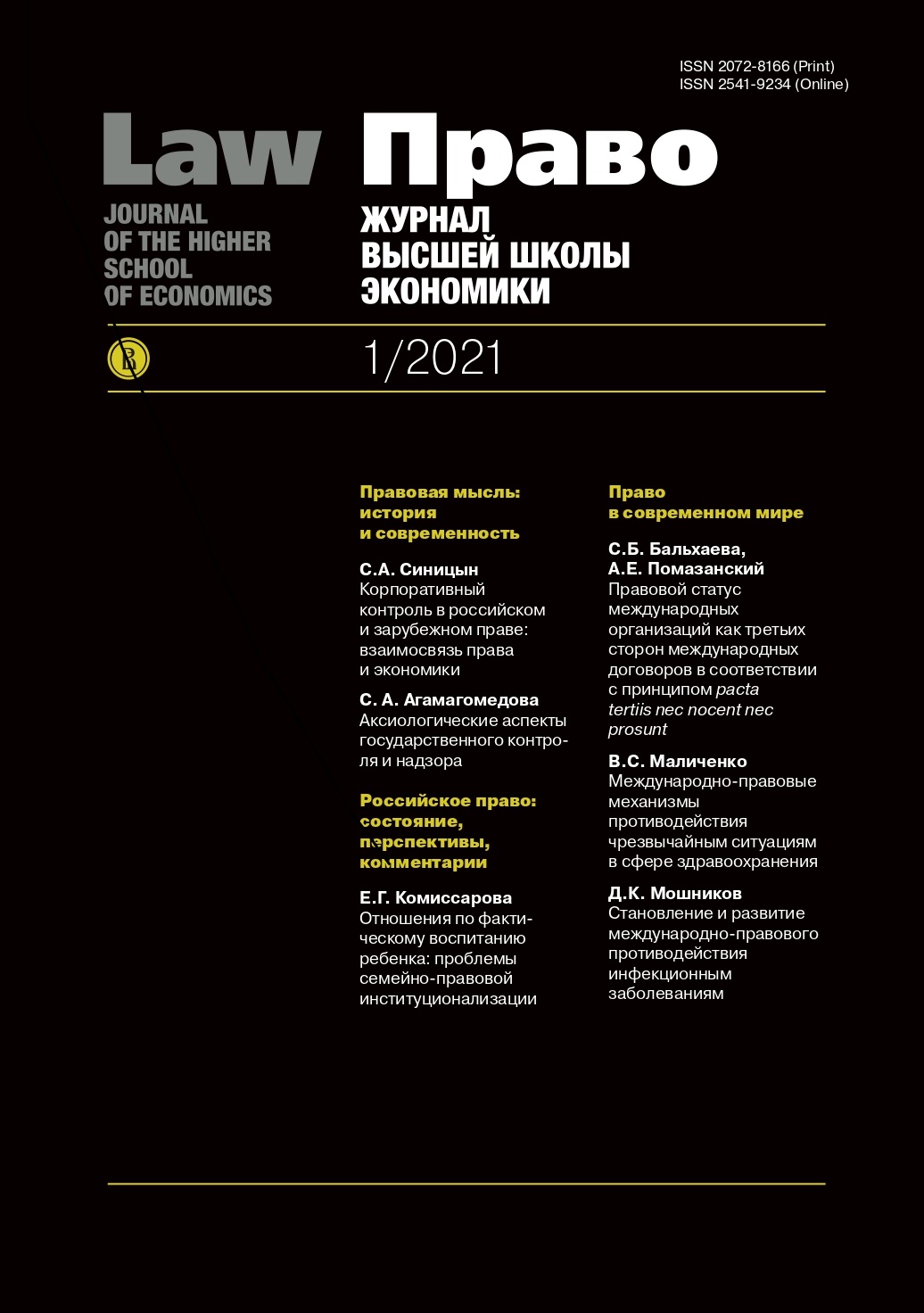Мусульманское право в контексте правогенеза
Аннотация
Тема настоящей статьи актуальна прежде всего вследствие недостаточной разработанности общетеоретической концепции правогенеза, в рамках которой становление мусульманского права подтверждало бы ее правильность. Используемая в этом качестве концепция, преобладающая в российской правовой литературе и исходящая из неразрывной связи государства и правогенеза, «пробуксовывает» в ряде аспектов. Выяснение причин такого положения — одна из целей настоящей статьи. Другая цель состоит в попытке наметить методологию исследования проблемы правогенеза на ее теоретическом уровне и применительно к мусульманскому праву. Автор рассматривает правогенез в контексте концепции всемирной эволюции. При таком подходе социальным факторам возникновения права предшествуют природные факторы такого же характера, а исходным в исследовании становится тезис о возникновении права одновременно с человеческим обществом. Важнейшее значение приобретает вывод, что закономерности развития поведения и механизмов его регуляции формируются уже на природной стадии всемирной эволюции. Возникнув на уровне рефлексов, они воспринимаются затем слитными нормами обычая–мононормы. В свою очередь, шариат как основа мусульманского права по существу воспроизводит в условиях раннеклассового общества основные параметры мононормы: сверхъестественный характер ее возникновения, слитность, неизменность, беспробельность, отсутствие необходимости в аппарате, способном принуждать к соблюдению норм шариата. Структура мусульманского права отражает также влияние зарождающейся цивилизации. Ее разнотипность с культурой мононормы обусловила необходимость религиозно-правовых школ как связующего звена между неизменными нормами шариата и изменяющимися общественными отношениями. В результате появилась исламская юриспруденция, или фикх. В характере функций, выполняемых школами и направленных на поддержание в рабочем состоянии слитных (и потому неизменных) норм шариата, автор видит закономерность, типичную для раннеклассовых правовых систем и теоретически недостаточно осмысленную. Структура мусульманского права и сегодня включает элементы раннеклассовой эпохи.
Литература
Alekseev S.S. (1994) Theory of law. Moscow: BEK, 221 p. (in Russian)
Alekseev V.V. (ed.) (2014) Theory and methodology of law. Volgograd: Uchitel', 503 p. (in Russian)
Allott A.N. (1965) Law and language. London: University press, 31 p.
Arsanukaeva M. (2004) Mashaby — schools of Islamic legal thought. Sovremennoe parvo, no 7, pp. 52-60 (in Russian)
Arsanukaeva M. (2004) Sunni Mashaby: origin and development. Religiya i pravo, no 2, pp. 24-26 (in Russian)
Artemov V.U. (2007) Sources and doctrines of Muslim law. Zhurnal rossiyskogo prava, no 3, pp. 128-136 (in Russian)
Belomestnova N.V. Plebanek O. V. (2012) Conscience and culture in scholar worldview. Voprosy filosofii, no 10, pp. 43-52 (in Russian)
Chestnov I.L. (2006) Historical causes of state and law. In: Teoriya gosudarstva i prava. Saint Petersburg: Peter Press, pp. 41-95 (in Russian)
Darvin Ch. (1986) Origin of Species by Means of Natural Selection. Moscow: Prosve-chenie, 484 p. (in Russian)
Drobischevskiy S.A. (1994) Political organization of society and law. Doctor of Juridical Sciences Summary. Saint Petersburg, 40 p. (in Russian)
Dumanov H.M., Perschiz A.I. (2000) Mononorm and initial law. Gosudarstvo i pravo, no 1, pp. 98-104 (in Russian)
Engels F. (1989) Origin of family, private property and state. Moscow: Politizdat, 240 p. (in Russian)
Gegel G. (2009) Philosophy of law. Moscow: Nauka, 415 p. (in Russian)
Gurevich A.Ya. (1984) Categories of medieval culture. Moscow: Nauka, 350 p. (in Russian)
Ismaylov A.Sh. (2009) Mashaby in Islam. Islamovedenie, no 2, pp. 15-27.
Jung K. (1998) Psychology of the Unconscious. Moscow: Pedagogika, 397 p. (in Russian)
Kartaschov V N. (2018) State and law theory. Yaroslavl: University, 359 p. (in Russian)
Khaidarova M.S. (1984) Major theories and schools in Muslim law. Muslim Law (structure and institutions). V.E. Chirkin, L.R. Sjukiyainen (eds.). Moscow: Nauka, pp. 38-48 (in Russian)
Khallyak V. (2020) History of Islamic legal theories. Moscow: HSE, 463 p. (in Russian)
Kolesnikov P.M. (2012) Muslim law in legal systems of the Middle East. Moscow: Russian Legal Academy, 142 p. (in Russian)
Komarov S.A. (1998) General theory of state and law. Moscow: Jurist, 406 p. (in Russian)
Korel'skiy V.M., Perevalov V.D. (1998) Theory of state and law. Moscow: Nauka, 450 p. (in Russian)
Kubbel L. (1988) Essays on political ethnography. Moscow: Nauka, 268 p. (in Russian)
Kulanzh F. de (1903) Ancient civil community. Moscow: Sytin, 405 p. (in Russian)
Leontyev A.N. (1971) Necessities, motives and emotions. Moscow: MGU, 65 p. (in Russian)
Lotman Yu.M. (1978) Phenomenon of culture. Uchenie trudi Tartusskogo universiteta, no 10, pp. 3-17 (in Russian)
Machin I.F. (1999) On the origin of law. In: Issues of theory state and law. M. N. Marchenko (ed.). Moscow: MGU, pp. 81-99 (in Russian)
Maltsev G.V. (1999) (a) Customary theory and common law. In: Law in Russia: theory, history and applying. Rostov: University, pp. 7-94 (in Russian)
Maltsev G.V. (1999) (b) Origin and early forms of law and state. In: Aspects of theory of state and law. V. S. Nersesjants (ed.). Moscow: Norma, pp. 27-115 (in Russian)
Morozova L.A. (2015) Theory of state and law. Moscow: Yurist, 414 p. (in Russian)
Perschiz A.I. (1979) Aspects of normative ethnography. Issledovaniya po obschei etnografii. Moscow: Nauka, pp. 210-240 (in Russian)
Pigolkin A.S. (ed.) (2008) General theory of law. Moscow: Prospekt, 485 p. (in Russian)
Piotrovskiy M.B. (2008) Fikh. Schariat. Islam. A manual. Moscow, pp. 110-111, 132-133 (in Russian)
Rasskasov L.S. (2015) Theory of state and law. Moscow: 650 p. (in Russian)
Roe M. (2019) Islamic law: history and modern times. Moscow: Medina, 576 p. (in Russian)
Rubinschtein S.L. (2015) Basics of psychology. Saint Petersburg: Piter, 705 p. (in Russian)
Saidov A.H. (2008) Hidoya by Burharuddin Marginani as a unique juridical monument of Islam. Moscow: Wolters Kluwer, pp. 15-49 (in Russian)
Sechenov I.M. (1952) Selected works. Moscow: Meditsina, 235 p. (in Russian)
Sinitsina I.E. (1978) Customary law in modern Africa. Moscow: Nauka, 285 p. (in Russian)
Sukiyainen L.R. (1991) Al-Fikh. Sharia. In: Islam. Encyclopedia. Moscow: Medina, pp. 254-257, 292-294 (in Russian)
Sukiyainen L.R. (2018) Fiqh as a reflection of legal features of Islamic law. Pravo. Zhurnal Vysshey shkoly ekonomiki, no 3, pp. 50-80 (in Russian)
Sukiyainen L.R. (2001) Fetva. Fiqh. Shariat. In: Yuridicheskaya entsiklopediya. Moscow: Yurist, pp. 1153-1156, 1197-1198 (in Russian)
Sukiyainen L.R. (2019) Fiqh as a source of modern law in Arabic countries. Pravo. Zhurnal vysshey shkoly ekonomiki, no 4. pp. 222-245 (in Russian)
Sukiyainen L.R. (1997) Schariat and muslim legal culture. Moscow: Nauka, 99 p. (in Russian)
Schalyutin B.S. (2011) Genesis of law as a factor of the development of society and humanity. Voprosi filosofii, no 11, pp. 51-62 (in Russian)
Valeev L.Zh. (1974) Common law and initial stages of its genesis. Pravovedenie, no 6, pp. 71-79 (in Russian)
Vasilyev L.S. (1999) A history of Eastern religions. Moscow: Nauka, 415 p. (in Russian)
Vengerov A.B. (1983) Ethnography and archeology for legal science. Sovetskoe gosudarstvo i pravo, no 3, pp. 28-36 (in Russian)
Viljunas V.K. (1986) Psychological mechanisms of biological motivation. Moscow: MGU, 207 p. (in Russian)
Copyright (c) 2021 Право. Журнал Высшей школы экономики

Это произведение доступно по лицензии Creative Commons «Attribution-ShareAlike» («Атрибуция — На тех же условиях») 4.0 Всемирная.


















